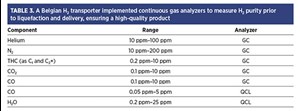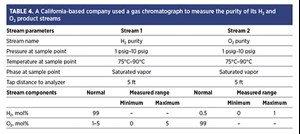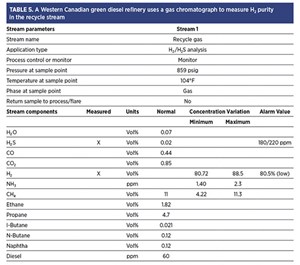Articles
Ensure H2 purity with modern gas analyzers
H2 Equipment and Services
D. GUYMER, Emerson, Cumbernauld, Scotland
As the world grapples with decarbonization and alternative power supplies to reduce global greenhouse gas (GHG) emissions, more ways to condition, store and distribute energy from new fuel sources are needed. To that end, hydrogen (H2) gas applications play a major role in global sustainability initiatives.
While batteries are being used to harness and store power in small- and mid-scale applications, they are not ideal for larger applications due to cost, weight and other factors. Even when used to power electric vehicles (EVs)—perhaps the most predominant mid-scale example—they present several drawbacks.
Although the primary metal contained in modern lithium-ion cells is readily available with no near-term shortage in sight, other battery components come with negative environmental and societal repercussions, especially in some developing countries where the minerals are harvested. Additionally, batteries are subject to degradation, losing around 2.3%/yr of capacity, and to power loss of about 1% of capacity per week, depending on the application.1
With EVs, grid capacity and charging infrastructure pose limitations, especially in long-distance transport, where frequent and time-consuming recharging is required. Furthermore, charging technology is only available in limited locales.
H2 provides a more viable answer to the energy storage problem because:
- It is not subject to degradation or noticeable energy leaks
- It has a very high energy density of 35,000 watts/kilogram (kg), while lithium-ion batteries have a density of just 200 watts/kg
- It can supplement natural gas to power homes and industry using existing power generation infrastructure
- It is easily transported
- H2 fuel cell-powered vehicles are refueled at a similar speed to those with internal combustion engines
- Burning H2 produces only water as a byproduct, absent of carbon dioxide (CO2), nitrous oxide (NOx) or GHGs.
Sourcing H2. H2 is produced by many paths, classified as a color by the eco-friendliness of its production process and can be designated as gray, blue, turquoise or green (FIG. 1).
Gray H2 is produced via steam methane reforming (SMR) of natural gas, oil, coal or another hydrocarbon according to one of these chemical formulas (Eq. 1):
CH4 + H2O ↔ CO + 3H2 (1)
CO + H2O ↔ CO2 + H2
or
CH4 + 2H2O ↔ CO2 + 4H2
SMR is the most common process for producing H2 today; however, it has the drawback of releasing carbon monoxide (CO) or CO2 into the atmosphere, which reduces environmental benefits gained by consuming the H2 later in its lifecycle. Blue H2 solves the issue of carbon release, using the same SMR chemical processes but capturing and storing the waste carbon byproducts to prevent release into the atmosphere.
Like gray and blue H2, turquoise H2 also uses methane (CH4) as a feedstock—but the process is driven by heat produced with electricity rather than through the combustion of fossil fuels—in a process known as CH4 pyrolysis.
Like blue and gray H2 production, CH4 pyrolysis produces H2 and carbon, but unlike SMR, the carbon byproduct is generated as a solid instead of a gas. As a result, there is no requirement for carbon capture, and storage is greatly simplified.
Green H2 is the most environmentally friendly form, produced via renewable energy-powered water electrolysis. Chemically, the process is (Eq. 2):
2H2O ↔ 2H2 + O2 (2)
With electrolysis, no carbon or other pollutants are produced. However, transforming water into its di-elemental constituents requires more energy than generating H2 from fossil fuels. For this reason, a small percentage of the H2 produced today is green H2.
Regardless of the source, H2 purity is a necessary consideration for every application. The International Standard Organization’s (ISO’s) 14687 standard was created to correlate applications and uses with required H2 purity.
Ensuring H2 purity with ISO 14687. ISO 14687 specifies the quality tolerances for H2 fuel, primarily focused on stationary, vehicular and proton exchange membrane (PEM) fuel cell uses. Depending on the application, each gas grade defines an acceptable impurity allowance (TABLE 1).
Grades A–C comprise direct burning applications, requiring measurement of impurities that pose environmental risks when released. Grades D and E cover power generation through fuel cell applications, primarily concerned with impurities that can poison the cell. The acceptable impurities are broken down into allowable contaminants in TABLE 2.
As the tables show, the acceptable purity and contaminants vary considerably by application.
Measuring H2 purity. The two main modern ways of measuring H2 purity are gas chromatography (GC) and continuous gas analysis. GC relies on a thermal conductivity, flame ionization or micro flame photometric detector. Thermal conductivity detectors are mainly used to measure inert gases and most hydrocarbons, while flame ionization detectors are adept at measuring trace hydrocarbons, and micro flame photometric detectors specialize in measuring low-level sulfur species.
However, a GC analyzer cannot individually measure argon and oxygen when both are present, has a high detectable lower-range value for water—which does not comply with ISO 14687—and requires a relatively long response time, measured in minutes. When any of these requirements need to be met, continuous gas analyzers provide better options.
There are several continuous gas analysis technologies on the market, including laser absorption spectrometry analyzers [e.g., quantum cascade laser (QCL) technology], non-dispersive infrared and ultra-violet photometers, thermal conductivity detectors, electrochemical sensors and paramagnetic oxygen detectors.
QCL analyzers measure components using mid-range infrared spectroscopy and tunable diode laser spectroscopy to make low-ppm measurements over a host of molecules. Modern continuous gas analyzers are configurable to provide a wide range of measurements. However, GC analyzers provide lower detection limits than continuous gas analyzers for inert gases. The following examples demonstrate how GCs and continuous analyzers can be applied to measure H2 purity.
APPLICATION EXAMPLES
Distributing pure H2. A Belgian H2 transporter needed to ensure product purity in its liquid H2 custody transfer process. The company implemented a GC and QCL-based continuous gas analyzer on the incoming H2 stream prior to cryogenic liquefaction for transport, as shown in TABLE 3.a,b
The transporter relied on the GC analyzer to perform comprehensive impurity composition analysis, with multi-minute cycle time and relied on the QCL analyzer to provide real-time, continuous analysis of critical components for process control.
Electrolysis purity analysis. A California-based company using electrolyzers implemented the technology to monitor the purity of its two main products, oxygen and H2 gases. To do this, it used a GC with two streams,a one to measure H2 and the other to measure O2 (TABLE 4). By implementing reliable purity measurements, the company significantly reduced the risk of producing off-spec H2 fuel, which can cause severe damage to H2 fuel cells.
Refining green diesel. Green diesel is most frequently produced by reacting recycled animal fats, used cooking oil and inedible corn oil under elevated temperatures and pressures in the presence of a catalyst (FIG. 2). The product can supplement or even replace conventional fuel in diesel engines without any modification to the engines, and it produces far less GHG emissions than conventional diesel fuel when burned. Green diesel is sold in California, Canada and Europe, where it meets the low-carbon fuel classification.
A green diesel refinery in Western Canada installed a GCa to measure H2 purity concentration in the recycle stream (TABLE 5).
The refinery also installed a non-dispersive infrared photometry-based continuous gas analyzerc to measure carbon H2 impurities at the H2 pressure swing adsorption outlet (TABLE 6). The measurements empowered the company to ensure its green diesel met regulatory standards while providing a safe and reliable alternative to conventional diesel.
Preparing for decarbonization. Purity must be considered in H2 applications to avoid equipment fouling, process failures or end-user issues. ISO 14687 lays a foundation for understanding purity requirements, and it details which components must be measured in each application; however, the list is not exhaustive.
The ideal mix of gas analyzers for each application depends on the purity requirements and potential contaminants, the latter determined by the H2 source. For example, green H2 produced via electrolysis has no risk of hydrocarbon or sulfur contamination, so measuring for these impurities is not necessary.
As the world further reduces its dependency on fossil fuels, the need for uncontaminated H2 gas for power generation and storage will continue to increase. While no single-analyzer solutions are on the market to universally measure all possible H2 contaminants, the technologies are progressing quickly, helping processors ensure pure products for maximum reliability, uptime and profitability.H2T
About the author

DAN GUYMER is the application engineering lead for Rosemount Continuous Gas Analyzers at Emerson’s Gas Analysis Solutions Center in Cumbernauld, Scotland. He has been with Emerson for 6 yr, initially working as a gas chromatograph application engineer before moving to continuous gas analyzers. Guymer has an MS in chemistry from the University of Aberdeen, with a research placement at the University of Bonn in Germany.
NOTES
a Rosemount™ 700XA Gas Chromatograph
b Rosemount™ CT5800 Continuous Gas Analyzer
c Rosemount™ X-STREAM Enhanced XEFD Continuous Gas Analyzer
LITERATURE CITED
1 J.D. Power, “How long do electric car batteries last?” September 2022, online: https://www.jdpower.com/cars/shopping-guides/how-long-do-electric-car-batteries-last









